Berkeleyan
Celebrating Sagehen
![]()
02 September 2004
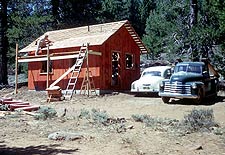 Sagehen Creek Field Station, circa 1954. Starting with a small cabin, a pair of tent platforms, and a storage shed, the station has grown into a complex of 19 buildings, two classrooms, office space, and a fish observation house. After years of decline, Sagehen’s aging facilities are getting a facelift. (Paul Needham photo) |
Fine points of lower math aside, the revelers did have a more timely cause for celebration. Earlier this year, the UC Regents designated the field station, about 20 miles north of Lake Tahoe, as the 35th site in the University of California Natural Reserve System. Sagehen’s inclusion in the system represented the culmination of years of effort by a wide range of interested parties, from local community activists and U.S. Forest Service representatives to Berkeley administrators, Sagehen staff, and NRS personnel.
Many of those “alumni” returned intending to rekindle old friendships. In the process, they discovered the extent of Sagehen Creek’s continued role in addressing pressing environmental issues, from fish and wildlife conservation to wildfire management.
Located just over the crest of the Sierra Nevada in Tahoe National Forest, the field station offers unparalleled research and instructional opportunities. Though it occupies just 450 acres, the station enables access to nearly 8,000 additional acres of Truckee River watershed, featuring mountain meadows and fens, montane chaparral, and extensive stands of yellow-pine, mixed- conifer, and red-fir forests. The area’s diverse biota includes more than 500 species of vascular plants, 212 species of vertebrates, and 340 families of insects.
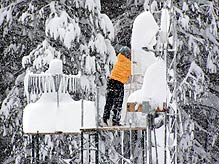 Through sun, rain, and snow — lots and lots of snow — the weather station has produced a blizzard of weather data spanning five decades. (Jeff Brown photo) |
During its five decades of existence, research at Sagehen has produced data from pioneering studies of the trout fishery and stream ecosystems, as well as long-term studies of the beaver, marten, and bird populations. The field station’s online database comprises more than 50 years of weather data, as well as biological inventories for am-phibians, birds, bony fishes, insects, mammals, plants, and reptiles. The station also maintains substantial collections of higher plants, vertebrates, and insects at the site.
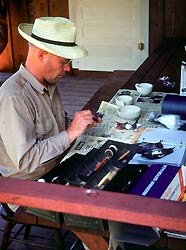 Paul “PR” Needham, who founded Sagehen with Professor of Wildlife Management A. Starker Leopold, loved wild trout, and wanted a place to study them. (Courtesy Reg Barrett) |
Beth Burnside, vice chancellor for Research at Berkeley, led the effort to bring Sagehen into the NRS. “I’ve had a continuing interest in how field stations function and survive,” she explained, citing her long relationship with the Bermuda Biological Station for Research. “I was trained as a zoologist, and I like the kind of research that goes on at these sites, but I’m also aware of the kinds of challenges that such remote units have to deal with.”
By the time she became vice chancellor in January 2001, Sagehen’s facilities had fallen into serious disrepair. Burnside held a few meetings on campus to gauge support for the site but received little encouragement. One faculty member bluntly advised her to give it back to the Forest Service.
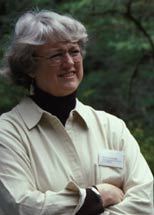 Beth Burnside, Berkeley's vice chancellor for research, was a driving force behind Sagehen's entry into the Natural Reserve System. (Alex Glazer photo) |
Throughout its history, Sagehen has built up a huge reservoir of support among former researchers, students, and staff. “It’s an imprinting mechanism,“ observed Burnside. “Once people get hooked on a field station as undergraduates or as graduate students, they’ll dream up experiments or studies to try to get back there. What I’m trying to do is get enough resources into Sagehen, to build up an appropriate infrastructure so that it can attract the people who will then continually renew it.”
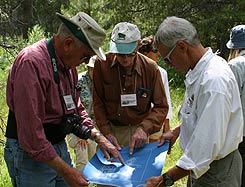 Sagehen alumni Glenn Flittner (left) and Dick Gard (center) examine a map that Flittner drew as a grad student in the early 1950s, while station manager Jeff Brown looks on. Flittner helped bulldoze the original site; Gard led field work for founder Paul Needham’s 10-year fish survey. (Jerry Booth photo) |
Needham and Leopold — who, in the winter of 1950, first met with U.S. Forest representatives at a wide spot on U.S. Highway 89 to outline their vision — would have been pleased.
For more on Sagehen and the research that has been conducted there for the past half century, see the Summer 2004 issue of Transect (nrs.ucop.edu/publications/transect.html), from which this text has been adapted.

